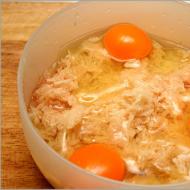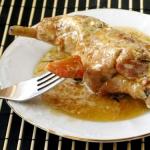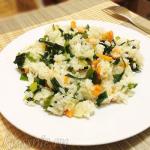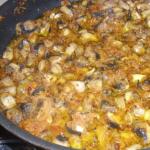
Is an omelette with milk high in calories. How many calories in scrambled eggs of different types
Omelet natural rich in such vitamins and minerals as: vitamin A - 22.2%, vitamin B2 - 16.7%, choline - 31%, vitamin B5 - 18%, vitamin B12 - 16.7%, vitamin D - 13%, vitamin H - 26.2%, phosphorus - 19.2%, chlorine - 49.3%, cobalt - 64%
What is useful Omelette natural
- Vitamin A is responsible for normal development, reproductive function, skin and eye health, and maintaining immunity.
- Vitamin B2 participates in redox reactions, increases the susceptibility of color by the visual analyzer and dark adaptation. Inadequate intake of vitamin B2 is accompanied by a violation of the condition of the skin, mucous membranes, impaired light and twilight vision.
- Choline is part of lecithin, plays a role in the synthesis and metabolism of phospholipids in the liver, is a source of free methyl groups, acts as a lipotropic factor.
- Vitamin B5 participates in protein, fat, carbohydrate metabolism, cholesterol metabolism, the synthesis of a number of hormones, hemoglobin, promotes the absorption of amino acids and sugars in the intestine, supports the function of the adrenal cortex. A lack of pantothenic acid can lead to damage to the skin and mucous membranes.
- Vitamin B12 plays an important role in the metabolism and transformations of amino acids. Folate and vitamin B12 are interrelated vitamins involved in hematopoiesis. A lack of vitamin B12 leads to the development of partial or secondary folate deficiency, as well as anemia, leukopenia, and thrombocytopenia.
- Vitamin D maintains homeostasis of calcium and phosphorus, carries out the processes of mineralization of bone tissue. A lack of vitamin D leads to impaired calcium and phosphorus metabolism in bones, increased demineralization of bone tissue, which leads to an increased risk of osteoporosis.
- Vitamin H participates in the synthesis of fats, glycogen, amino acid metabolism. Insufficient intake of this vitamin can lead to disruption of the normal condition of the skin.
- Phosphorus takes part in many physiological processes, including energy metabolism, regulates the acid-base balance, is part of phospholipids, nucleotides and nucleic acids, is necessary for the mineralization of bones and teeth. Deficiency leads to anorexia, anemia, rickets.
- Chlorine necessary for the formation and secretion of hydrochloric acid in the body.
- Cobalt is part of vitamin B12. Activates the enzymes of fatty acid metabolism and folic acid metabolism.
A complete guide to the most useful products you can see in the application
Calories in 2 egg omelette with milk, How many calories in 2 egg omelette with milk
The main ingredients for an omelet are traditional eggs and milk, and as for other products sometimes used, it depends on the preferences and tastes of the person for whom this dish is intended.
An omelet is cooked very quickly, so it is often made for breakfast. But many people who care about the figure are interested in how its use will affect it.
1. Calorie content of an omelet from 2 eggs with milk
Calorie content of an omelet from 2 eggs with milk in one serving (167 grams) 239 kcal.
100 g of the product contains
- 15.4 g protein
- 17.7 g fat,
- 3.1 g of carbohydrates.
Calorie content is indicated for a dish of 2 eggs, 5 ml of sunflower oil, 2 g of salt and 50 ml of 1.5% milk.
2. How many calories are in an omelette without yolk
In an omelette with vegetables without yolks (100 gr) is:
- Proteins - 7.6 gr;
- Fat - 8.2 gr;
- Carbohydrates - 2.6 gr;
- The calorie content of the product is 111 kcal.
For many people, such an omelet recipe loses its palatability, but the choice is up to the consumer: either food with a lower calorie content, or the taste of the product. In an omelet with vegetables, the absence of yolks in the product will not be so noticeable, since each vegetable brings its own individual “notes” to the dish.
3. Calorie omelet with cheese
Calorie omelette with cheese per 100 grams 158 kcal.
In 100 g of product
- 13.9 g of proteins,
- 11 g fat
- 0.8 g of carbohydrates.
4. Calorie omelette with tomatoes per 100 grams
Calorie omelette with tomatoes per 100 grams 152 kcal.
100 g of the product contains
- 7.1 g of proteins,
- 12.6 g fat,
- 1.9 g of carbohydrates.
In 1 ready-made 130-gram serving of the dish, 196 kcal,
- 9.2 g protein
- 16.3 g fat,
- 2.5 g of carbohydrates.
5. How many calories are in an omelette without butter
Calorie content of 100 g of various oils on which omelet is prepared by most people:
- Olive - 198 kcal;
- Sunflower - 578 kcal;
- Creamy - 748 kcal;
- Peanut and corn - 899 kcal each.
We remove 20-30 grams of oil from the recipe, and we get significant savings in kilocalories consumed. Of course, frying an omelet in a pan on a gas stove without any oil will not work, but cooking a delicious product in the oven, slow cooker is easy and simple. You can also cook an omelette without oil in the microwave, but ...
6. Omelet from 2 eggs with milk and tomatoes
The calorie content of a simple omelet made from two eggs and milk, cooked with a minimum amount of butter, is 161 kcal.
The most popular variation of this dish involves the addition of tomato.
An omelette in milk with two eggs and the addition of a tomato contains 151 kcal per 100 grams.
To reduce the energy value of the dish, you can use skim milk or apply a few more tricks.
7. How many calories are in an omelet from 1 egg and milk
The calorie content of this recipe depends on the method of cooking the dish: in the oven, in a slow cooker, fry in a pan on a gas stove.
Cooking an omelette by frying on the stove is the most high-calorie and “dangerous” option for the body: during frying, various fats, to a greater or lesser extent, form carcinogenic substances that negatively affect metabolic processes in the body.
On average, an omelette with milk and one egg has 128.5 calories per 100 grams.
What are the benefits of an omelette
When consumed in moderation, the benefits of an omelet are quite large:
- the dish is saturated with vitamins and minerals that strengthen the immune system;
- omelette is indicated for chronic muscle and headaches;
- the B vitamins contained in the omelette are beneficial for the health of the nervous system;
- the main component of an omelet is chicken eggs, which are rich in vitamins A, E, D;
- omelette vitamin A - a natural antioxidant that is beneficial for the health of bones, eyes, skin, as well as the regulation of protein synthesis during oxidative and reduction processes;
- omelette B vitamins are useful for maintaining muscle tone, accelerating metabolism;
- vitamin E in the product is necessary to increase the elasticity of blood vessels, rapid wound healing;
- The calcium and carbonate of the eggs in the dishes are used to stimulate the bone marrow.
The harm of an omelet The following harmful properties of an omelet are known: the cholesterol contained in the dish clogs the blood vessels; overcooked omelette loses up to 95% of nutrients; an omelette made from low-quality eggs can cause salmonellosis; many people develop allergic reactions to the components in the composition of the dish, including intolerance to egg proteins and butter.

How to make a delicious omelette

To prepare the dish you will need:
- 3 chicken eggs,
- 35 g butter,
- a quarter teaspoon of salt
- a fifth of a teaspoon of ground pepper.
Cooking steps:
- Beat the eggs with a fork until the mass becomes homogeneous.
- Try not to overdo it: too beaten eggs can cause the omelet to be very dense.
- Put 35 g of butter in a well-heated frying pan over medium heat.
- As soon as the butter is melted, the previously obtained egg mixture is poured onto it.
- Frying an omelette lasts 1.5 - 2 minutes.
- An indicator of the readiness of the dish is a golden crust on the sides, a slightly viscous middle. The finished omelet is removed from the heat, sprinkled with ground pepper, salt. The dish goes well with rye bread, vegetables. Enjoy your meal!
Calorie omelette per 100 grams 184 kcal. 100 g of the product contains: 9.6 g of proteins; 15.4 g fat; 1.9 g of carbohydrates. The vitamin and mineral composition of the omelet is represented by vitamins A, B2, B9, B12, E, D, calcium, potassium, lecithin, iron, lutein, selenium.
The average calorie content of 100 grams of omelet is 185 kcal.
It contains:
- carbohydrates 2 gr.;
- proteins 11 gr.;
- fat 15 gr.
An omelette can be made from different amounts of eggs and milk of any fat content, so when calculating individual energy value, you need to know the base load:
In 100 gr. eggs 157 kcal, and in the same amount of milk with a fat content of 3.2% - 59 kcal.
Based on this, you can determine the calorie content of the dish that you cook at home.
Outcome:
100 g of various omelette recipes contains (kcal):
- With one egg with milk - 128.5;
- With two eggs and milk - 178;
- In an omelette with milk and three eggs - 216;
- To the recipe for an omelette with tomatoes, you need to “plus” the calorie content of the vegetable - 30 kcal;
- In an omelette without yolks - 111;-
- In an omelette with water, we "minus" the energy value of milk - 64 kcal per 100 gr.
- In an omelette with broccoli, the energy value is higher by the calorie content of "overseas" - cabbage - 28 per 100 gr.
Low calorie omelet
Such a dietary dish is quite real, if prepared correctly. First of all, it is better not to fry an omelette: fried blues contain carcinogens that have a negative effect on the liver. And they, like the fats contained in the oil, lead to weight gain.

It is advisable to cook an omelet in a slow cooker or a double boiler.
It makes sense not to use the yolks:
in one hundred grams of an omelet on proteins alone, there are only 85 kcal.
Greens also reduce the energy value: parsley, basil, dill help the digestive system, and are excellent helpers in the fight against body fat.
The classic omelette, a favorite breakfast dish for the majority of the population of our country, is made from eggs beaten with milk, to which just one pinch of salt is added. However, many people prefer thicker omelettes, in which case wheat or corn flour is poured into the workpiece.
Be that as it may, dieters claim that scrambled eggs and everything connected with it are not suitable for those who follow their figure. Let's take a closer look at what an omelet is and how its use is associated with weight loss.
Omelet options
Depending on your imagination and preferences, an omelette can be completely without filler or with ham, and so on, including completely exotic fillings.  Any kind of omelet can be kneaded together with the chosen filler, as well as wrap the filling in the finished cake.
Any kind of omelet can be kneaded together with the chosen filler, as well as wrap the filling in the finished cake.
It is believed that an omelet with meat filling is more nutritious than with fish, but this difference is not too significant and should not become an obstacle in choosing the method of preparing this famous dish.
Usually an omelette is cooked in a very hot pan, but there are lovers who bake the product in the oven, slow cooker or microwave. It cannot be said that due to a different heat treatment, the calorie content of the omelet will decrease.
Calorie omelette
Indeed, a ready-made omelette made from 2 eggs with milk in a pan or oven cannot attract those who want to lose weight with a low calorie content - it is approximately 142.1 kcal per 100 grams. But this figure is easy to reduce, since a pure protein omelette without milk already boasts a calorie content of 58 kcal for the same weight, which will undoubtedly attract an incredible number of losing weight fans to this dish. Moreover, scrambled eggs are also presented in today's popular diet programs.
Omelet in dietetics
It's no secret that omelettes have long been used as supplements to various diets, including hypocaloric ones. This is due to the content of eggs in them. As you know, eggs contain an incredibly useful set of vitamins and minerals, such as, and.
 In addition, the frequent use of scrambled eggs helps to strengthen the nervous system shaken by the diet, which is important for those who first decided to limit themselves to food. At the moment, there are two diets that are extremely popular:
In addition, the frequent use of scrambled eggs helps to strengthen the nervous system shaken by the diet, which is important for those who first decided to limit themselves to food. At the moment, there are two diets that are extremely popular:
- hypocaloric(an omelette from one egg along with a glass of kefir is added to the breakfast menu);
- protein-egg(an omelette with cheese and greens, made from three eggs, is introduced into the morning diet with one cup of coffee with milk).
It must also be added that the scrambled eggs diet is not only allows you to quickly lose weight, but also helps to cleanse the body of harmful toxins and toxins. Don't forget to completely eliminate from the use of granulated sugar, and chocolate.
Classic omelet recipe
Many of us remember the thick and completely unappetizing omelettes of Soviet canteens, but today there is no need to cook them exactly like that - your skillful hands will help you in making the perfect classic omelet. To make your omelette truly delicious, choose from the following Components:
- 1 chicken egg;
- 25 ml of milk;
- 3 g of table salt;
- 2 g black ground pepper;
- 3 ml sunflower oil.
Put the pan on medium heat and add to it. stir a little in a deep bowl, then add to it. Beat the mass with a whisk or in a blender until completely homogeneous, add pepper and table salt. Stir the mass again and pour it into a preheated pan.
Fry the workpiece on one side for about 2 minutes, then turn over with a spatula. Cover the pan with a lid and fry the omelet until cooked through, the process will take another two minutes. Calorie omelet with milk from 1 egg in counting per 100 g is 106 kcal, from 3 eggs - 125.1 kcal.
Popular omelet recipes
The most delicious, safe and nutritious omelette can be easily prepared at home by reducing the standard calorie content by adding additional components to the preparation. How to do this is described in the recipes below.
Omelet with tomatoes
A very light and appetizing-looking omelette is made with fresh tomatoes and onions. To prepare it, use the following Components: 
- 2 chicken eggs;
- 100 g of onions;
- 200 g of tomatoes;
- 25 ml;
- 1 g of table salt.
We clean and rinse, then cut it into half rings. After that, put the resulting mass in a heated pan, pour oil. Cook over medium heat for about five minutes, stirring constantly. While the onion is fried, cut into thin slices.
Pour them to the onion, fry the mass for another minute or two. In the meantime, beat the eggs a little with salt, then pour the prepared vegetables with the resulting mixture. Cook the omelet for about five more minutes. calories per 100 g omelette with tomatoes is 76 kcal.
Cheese omelette
Those who love dishes with cheese will certainly appreciate this type of omelette despite the increased calorie content. To prepare it without problems, select the following Ingredients: 
- 1 chicken egg;
- 3 egg whites;
- 25 ml of milk;
- 3 ml sunflower oil;
- 50 g;
- 2 g of table salt.
Heat the pan in a skillet using medium heat. In the meantime, beat the egg with milk, beat the whites separately with table salt. We combine the two resulting mixtures in one bowl, beat in a blender or with a whisk for about a minute.
Separately, grate the cheese on a medium grater. Pour the mass into a frying pan, sprinkle with grated cheese and cook for about five minutes under a closed lid. Calorie omelet with cheese per 100 grams is 130 kcal.
Omelet with sausage
Sausage is considered a high-calorie product, but few can resist cooking this much-loved dish for breakfast or midday lunch. An omelette is perfect if you take the following Components: 
- 100 g of raw smoked sausage;
- 5 chicken eggs;
- 200 ml of milk;
- 50 g of onion;
- 20 ml sunflower oil;
- 2 g of table salt.
In a heated frying pan, heat the sunflower oil, at this time we cut the onion and sausage into cubes. Separately, beat the milk with eggs using a blender, adding a pinch of salt there. Pour the sausage with onions into the pan, mix with a spatula and fry for about five minutes, trying not to burn the components.
After that, pour the egg-milk mixture onto the sausage, cover the pan with a lid and cook the omelet on the lowest heat for about seven minutes. Calorie omelet with sausage per 100 grams is approximately 185 kcal.
squash omelette
Delicate omelet with delicious zucchini is a dietary dish recommended for those who are trying to lose weight. Baking in the oven makes this dish as light and tasty as possible. Its preparation is impossible without the following components:
We cut the zucchini into thin rings, and try to cut the tomato, onion and carrot into half rings. Lubricate a baking sheet or baking dish with oil, put carrots on it, then onions, zucchini and prepared tomato.  Sprinkle the workpiece with salt on top and bake the mass in the oven for about twenty minutes at a temperature of about 200 degrees.
Sprinkle the workpiece with salt on top and bake the mass in the oven for about twenty minutes at a temperature of about 200 degrees.
In the meantime, prepare the sauce: beat the eggs and whites with a blender, then add water and milk there. Beat a little more, remove the vegetables from the oven. Pour them with prepared sauce and sprinkle with chopped herbs.
Top with grated or finely chopped cheese and put the mold back into the oven. We stand the product there for about ten minutes. Calorie omelet with zucchini per 100 g kept within 75 kcal.
Try to use more greens during the preparation of different types of omelets. It will not only improve the taste of any dish, but will also contribute to the rapid absorption of food.
Everyone can boast that they know how to cook at least one dish of the famous French cuisine - an omelette. But how many calories does it have if you make it from 2 eggs and milk? Let's analyze the energy value of your favorite scrambled eggs on the shelves.
The perfect breakfast: simple, delicious, and… high in calories?
As a quick snack, many people cook themselves an omelet from 2 eggs. Its calorie content without oil depends on their size. Small ones weigh 30-40 g, medium ones - about 58, and large ones - 70 and even 90 g. In recipes, it is customary to take an average value - 40 g. In this case, the dish will have 118 kcal, and for 100 g - from 131 to 140 kcal . But this is if you cook it in the oven or steam. Since the traditional preparation of this dish involves heat treatment in the form of frying in a pan, you will have to use oil. It contains a lot of calories. Only 10 g of vegetable fat will add 90 kcal to the dish and increase the total calorie content to 230-250. And creamy is plus 74 kcal.
Important! If you replace natural eggs with egg powder, then the omelette will lose its taste and useful properties, and its energy “weight” will be 205 kcal.
To calculate the calorie content of an omelet from 2 eggs and milk prepared at home, you need to know the mass of each ingredient. If you follow exactly the recipe suggested in the cookbooks, then it will show 160-185 units of energy per 100 g (minimum - 115 kcal if the milk is low in fat). If you take 1 egg and beat it with milk, then there will be 85 kcal in the finished dish. Fans of large portions, who use 3 eggs, "eat" 230-240 kcal.
Dietary and not so: how do supplements change the energy value of a dish?

The most high-calorie and nutritious are omelettes with additives: cheeses, sausages, lard and other goodies. The first of these components has an energy reserve of 290 kcal per 100-gram piece. Therefore, an omelette of 2 eggs with cheese, the calorie content of which reaches 340-350 kcal, is not a dietary product.
Important! To improve the gastronomic properties, some people put bread cubes in scrambled eggs along with cheese. If you are worried about your figure, then it is better to abandon such experiments.
Ham is often added as well. With a calorie content of 145 units, it will "weight" the omelette and "reward" it with 198-09 kilocalories.
The poorest calories will be the following omelette options:
- protein - 55.7 - 70 units per 100 g;
- with spinach and pumpkin - 50 kcal;
- with tomatoes - 99 kcal. Interestingly, an ordinary tomato has a calorie content of 20 kcal (per 100 g), and cherry - 18;
- with bell pepper - 76.4;
- with mushrooms - 83;
- with broccoli - 104;
- with chicken fillet - 134;
- with vegetables, onions and tomatoes - 151-156 kcal.
Omelet for diets: five ways to reduce its nutritional value

If you approach this issue radically, then you need to cook it in a slow cooker or oven and exclusively from proteins. The calorie content of the dish will decrease by 3-4 times, but the taste of such a “culinary masterpiece” can only beat off the appetite for a long time.
Here are some more gentle ways to reduce the number of calories in your favorite food:
- take milk with a fat content of 2.5% (completely refuse cream, sour cream and homemade);
- use low-fat hard cheese;
- stew vegetables a little beforehand;
- fry completely without fat in a pan with a non-stick coating.
An omelette and scrambled eggs can be prepared even by the most “crooked / lazy” man, because no culinary talents are needed in this process. However, people who are struggling with excess weight should know how many calories are in a milk omelette with several eggs.
How many calories in an omelet from 1 egg and milk
The calorie content of this recipe depends on the method of cooking the dish: in the oven, in a slow cooker, fry in a pan on a gas stove.
Cooking an omelette by frying on the stove is the most high-calorie and “dangerous” option for the body: during frying, various fats, to a greater or lesser extent, form carcinogenic substances that negatively affect metabolic processes in the body.
On average, an omelette with milk and one egg has 128.5 calories per 100 grams.
How many calories in a 2 egg omelet with milk
The calorie content of 100 grams of an omelet from two eggs is 172 kcal. That is, the calorie content of an omelet from two eggs increases by the energy value of one egg (approximately).
After such a simple conclusion, it is easy to answer the question: “How many calories are in a 3-egg omelet with milk?” - 216 kcal.
You can reduce the calories in this omelette recipe by replacing milk with water. After all, the calorie content of an omelette with milk is much higher than a cooked product with water.
And then an admirer of chicken eggs will not ask the question that is framed by the subheading, but only: “How many calories are in an omelette of 2 eggs?”.
Below we consider ways to reduce the calorie content of an omelet from 2 yolks and 3 egg whites with milk.
How many calories in an omelet with tomatoes
The calorie content of an omelet with tomatoes increases by the energy value of vegetables: 100 g of tomato - 30 kcal. An omelette with tomatoes produces more liquid, which can be removed in various ways.
Tomatoes, bell peppers, pre-fried onions can be put:
- In an omelet with sausage;
- In an omelette with ham;
- In an omelette with sausage;
- In an omelette with cheese, bacon and other foods that have a high degree of fat content.
Nutritionists reasonably believe that, taking into account the quality of modern sausages and dairy products, it is better to dilute an omelet with vegetables with “good” water, fry in vegetable (olive) oil, without meat additives at all, sprinkle the finished product with various herbs (dill, parsley). , basil). To reduce the energy value of an omelet, you can remove the yolk from the eggs by adding a certain amount of flour to the omelet (how much depends on the person's culinary preferences).
How many calories in an omelette without yolk
In an omelette with vegetables without yolks (100 gr) is:
- Proteins - 7.6 gr;
- Fat - 8.2 gr;
- Carbohydrates - 2.6 gr;
- The calorie content of the product is 111 kcal.
For many people, such an omelet recipe loses its palatability, but the choice is up to the consumer: either food with a lower calorie content, or the taste of the product. In an omelet with vegetables, the absence of yolks in the product will not be so noticeable, since each vegetable brings its own individual “notes” to the dish.
Ways to reduce the calorie content of an omelet
- We prepare a product using household appliances. In an omelette in a slow cooker, a double boiler, there are slightly fewer calories. Naturally, in such an omelette there will be no appetizing crust loved by many;
- We reduce the number of eggs in the omelette, to a reasonable limit, and add various vegetables, herbs, do not use mayonnaise and ketchup;
- Cooking an omelette without yolks, on high-quality water (thawed). Any non-lazy person who has a refrigerator with a freezer can prepare melt water;
- We prepare an omelette without the use of any oil (even olive oil, “favorite” by all nutritionists).
How many calories in an omelette without butter

Calorie content of 100 g of various oils on which omelet is prepared by most people:
- Olive - 198 kcal;
- Sunflower - 578 kcal;
- Creamy - 748 kcal;
- Peanut and corn - 899 kcal each.
We remove 20-30 grams of oil from the recipe, and we get significant savings in kilocalories consumed. Of course, frying an omelet in a pan on a gas stove without any oil will not work, but cooking a delicious product in the oven, slow cooker is easy and simple. You can also cook an omelette without oil in the microwave, but ...
In our opinion, a special taste appears in an omelet in the oven, because the product is cooked not only from below, as on a gas stove, but also from above. We are sure that most of the "second" dishes baked in the oven, slow cooker are much tastier than those cooked on a gas stove.
In our opinion, a microwave omelet does not have that “taste zest” that makes a man say to a woman: “Thank you, dear, the omelet was delicious.” The microwave was not invented for gourmets, but for people who are constantly in a hurry somewhere.
draw the line
100 g of various omelette recipes contains (kcal):
- With one egg with milk - 128.5;
- With two eggs and milk - 178;
- In an omelette with milk and three eggs - 216;
- To the recipe for an omelette with tomatoes, you need to “plus” the calorie content of the vegetable - 30 kcal;
- In an omelette without yolks - 111;-
- In an omelette with water, we "minus" the energy value of milk - 64 kcal per 100 gr.
- In an omelette with broccoli, the energy value is higher by the calorie content of "overseas" - cabbage - 28 per 100 gr.
Most readers know the axiom of nutritionists: everything healthy is tasteless, and everything tasty is harmful to the body.
99.9% of people will agree with the fact that an omelette with yolks with milk and ham/sausage is much tastier than one without yolks and with water. And the second omelette recipe is healthier!
One can only express an opinion: it is difficult for adults to rebuild their "culinary addictions", but children need to be taught to eat right from an early age.
And then they will perceive proper nutrition (which is DELASTABLE), they will perceive it as the norm, and not like adults: a mockery of themselves in the name of health.
















